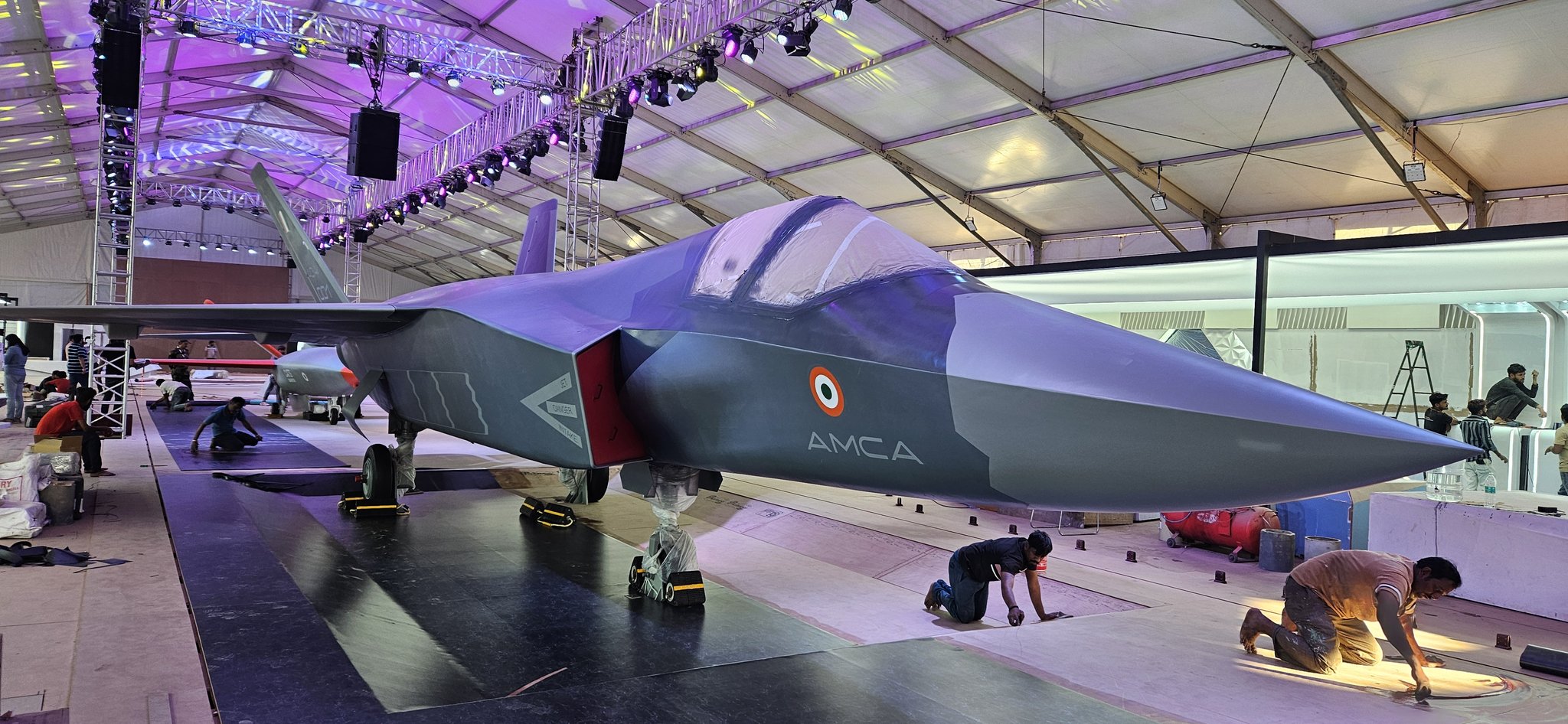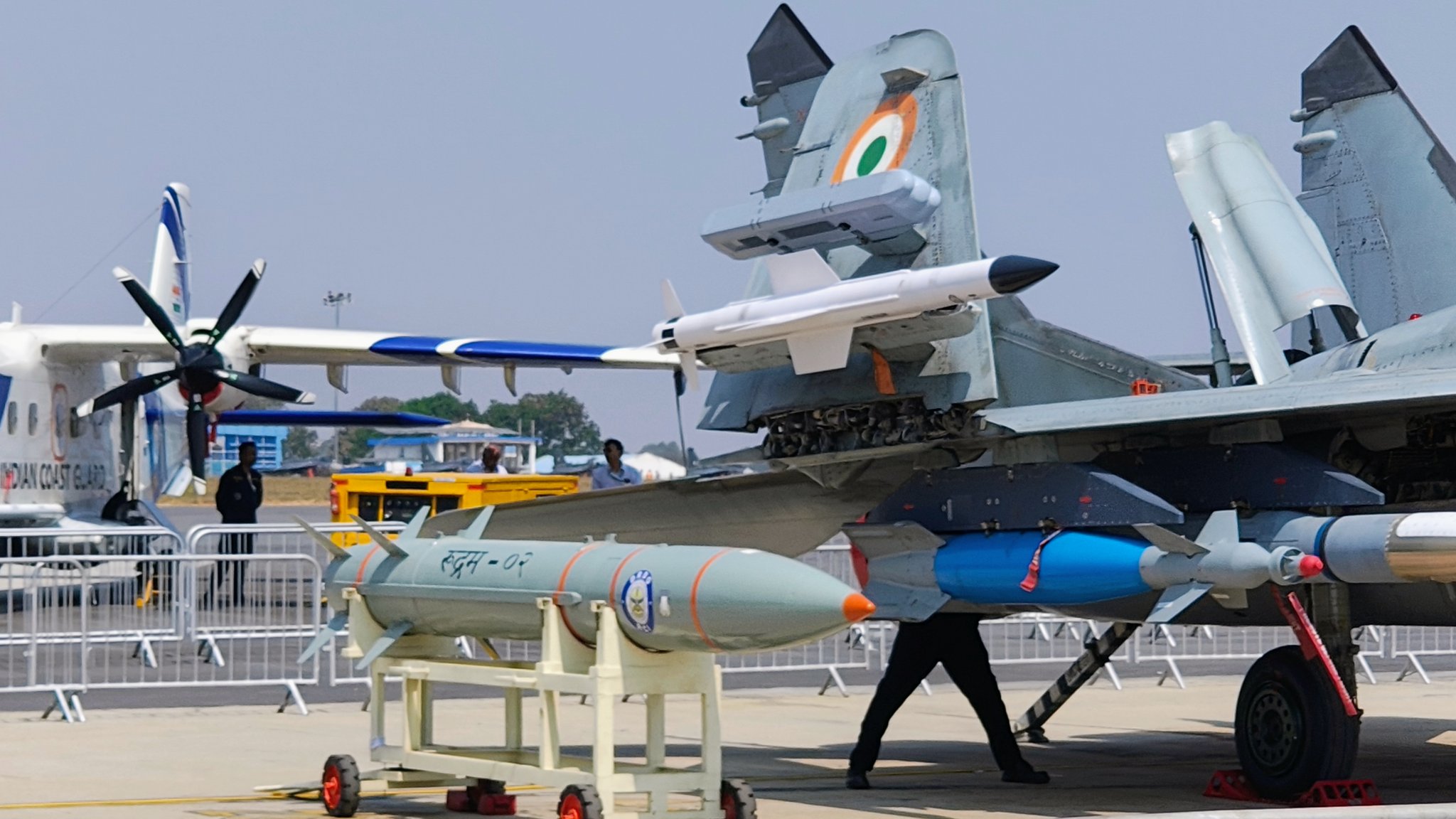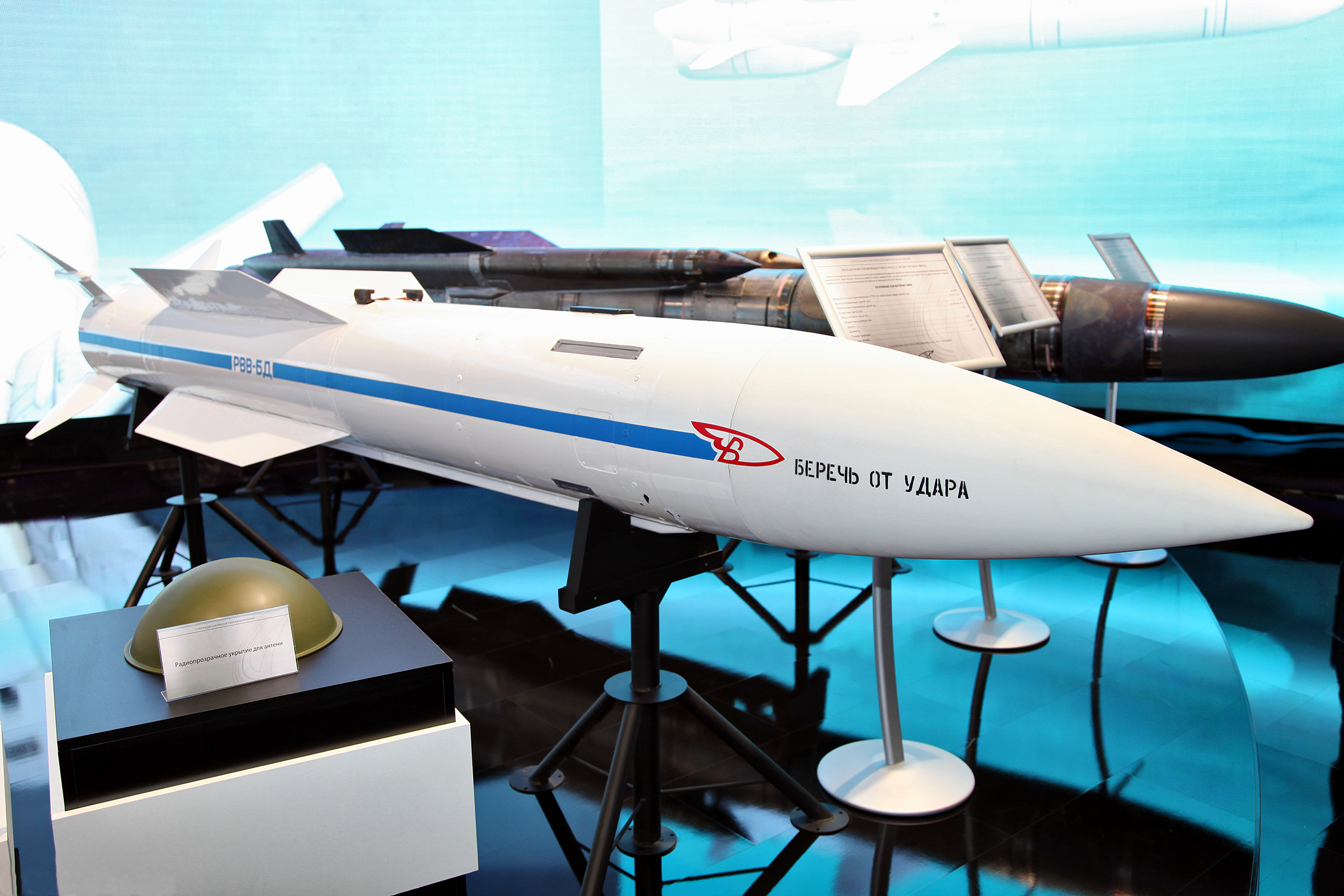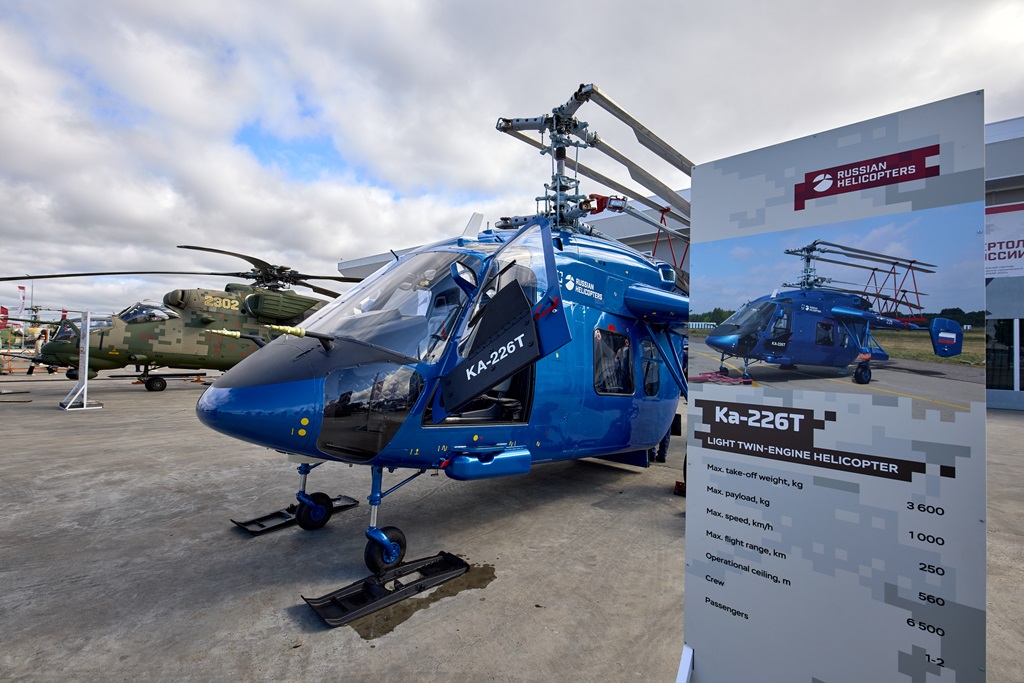admin
SOURCE: RAUNAK KUNDE / NEWS BEAT / IDRW.ORG


Jitendra J Jadhav, the Director-General of the Aeronautical Development Agency (ADA), has shared groundbreaking insights into the advanced technologies being incorporated into the Advanced Medium Combat Aircraft (AMCA), marking it as one of the most sophisticated fifth-generation fighter jets in the world.
AMCA is set to be a game-changer in the world of air combat, featuring a host of next-generation technologies aimed at enhancing stealth, combat efficiency, and operational capabilities. According to Jadhav, the AMCA will be powered by key 5th-generation innovations, making it one of the most advanced platforms in its class.
Continue readingSOURCE: RAUNAK KUNDE / NEWS BEAT / IDRW.ORG


@AjayshreeSamby3
In a significant advancement for India’s defense sector, Bharat Forge, a leading manufacturer based in Pune, has successfully rolled out its latest innovation: the MArG 155mm/45 calibre wheeled self-propelled howitzer. This new model represents an upgrade over its predecessor, the MArG 155mm/39 calibre, which was already integrated with the TC-20 ultra-lightweight truck.
The MArG 155mm/45 calibre howitzer is mounted on a 4×4 chassis, providing exceptional mobility and all-terrain capabilities. This system can handle gradients up to 30 degrees, showcasing its prowess in challenging environments. The design ensures that the howitzer can swiftly move into position, with an operational readiness time of just 1.5 minutes during the day and 2 minutes at night, which is crucial in dynamic combat scenarios.
Continue readingSOURCE: AFI


In a significant move to bolster its underwater capabilities, the Indian Navy has finalized a deal exceeding Rs 36,000 crore with Mazagon Dockyards Limited (MDL) for the construction of three additional Scorpene-class submarines. The contract, which is poised to be signed by March 31, 2025, marks a new chapter in India’s naval strategy but raises questions due to the steep increase in costs compared to previous acquisitions.
Each of the new submarines is set to cost around Rs 12,000 crore, a figure that has sparked considerable debate. This is nearly three times the cost of the six Scorpene submarines acquired under the initial Project-75, where each submarine was priced at approximately Rs 3,500 crore, totaling Rs 21,000 crore for all six. The significant price hike has not been thoroughly explained by officials, leaving room for speculation and concern over budgetary implications.
Continue readingSOURCE: AFI


At Aero India 2025, a significant display of India’s growing self-reliance in defense technology was witnessed as the indigenously developed RudraM-II Air-to-Surface missile was seen positioned near the Indian Navy’s MiG-29K. This visual confirmation indicates that RudraM-II, designed to neutralize a variety of enemy assets, is on track to be integrated with the naval fighter jet, expanding its tactical capabilities.
The RudraM-II is designed to be a game-changer in India’s air-to-surface missile capabilities, adding a significant edge to the Navy’s ability to target and neutralize enemy radar systems, missile defense installations, and other critical infrastructure from both low and high altitudes. It promises to enhance the Mig-29K’s strike capabilities, further strengthening India’s naval air power.
Continue readingSOURCE: AFI


Swedish defense giant Saab has introduced its innovative r-TWR deployable solution to the Indian Air Force, offering a new dimension to air traffic control (ATC) directly on the battlefield. This system, as described by Mats Palmberg, Chairman and Managing Director of Saab India, can revolutionize how air traffic services are managed, especially in dynamic and challenging operational environments.
The r-TWR, or Remote Tower, is designed to act as an air traffic control facility that can be deployed rapidly, with installation taking only one hour, and is portable enough to be transported by a C-130J aircraft. This capability makes it immensely valuable for military operations where traditional air traffic control towers might not be feasible or where the battlefield conditions are fluid.
Continue readingSOURCE: AFI


In a significant upgrade to its infantry capabilities, the Indian Army is slated to receive 70,000 AK-203 assault rifles this year, with an additional 100,000 units expected in 2026, as confirmed by defense sources. This procurement is part of an ongoing arms deal with Russia, aimed at modernizing the Army’s arsenal with one of the world’s most reliable and advanced assault rifles.
The AK-203 rifles, which have already seen an initial delivery of 35,000 units in 2024, are being manufactured under a joint venture between India and Russia at a facility in Amethi, Uttar Pradesh. This collaboration, under the banner of Indo-Russian Rifles Private Limited (IRRPL), signifies not just a step towards equipping the Indian forces with cutting-edge weaponry but also a move towards increasing indigenous defense manufacturing.
Continue readingSOURCE: IDRW.ORG


The Indian defense community was recently captivated by the first publicly available picture of the Archer-NG Medium-Altitude Long-Endurance (MALE) Unmanned Aerial Vehicle (UAV) going through taxi trials, a significant step toward its much-anticipated debut. This marks a major milestone in the development of the Archer-NG, which is set to become a cornerstone of India’s advanced UAV capabilities.
The Archer-NG is a weaponized MALE UAV designed to perform both intelligence, surveillance, reconnaissance (ISR) missions and precision strike operations. With a Maximum Take-Off Weight (MTOW) of 1,750 kg and the ability to carry a 300 kg (660 lb) payload, it is designed to offer long-endurance, high-speed, and high-performance capabilities, making it a highly versatile platform in modern warfare.
Continue readingSOURCE: IDRW.ORG


At Aero India 2025, a major milestone in India’s indigenous defense capabilities was showcased with the Advanced Self Protection Jamming Pod (ASPJ) developed for the Tejas Mk1A by the Defence Avionics Research Establishment (DARE) under the Defence Research and Development Organisation (DRDO). The ASPJ pod, which was seen flying on the LCA-Navy aircraft, has already undergone developmental trials on the Tejas Mk1 jets, marking a significant step towards enhancing the survivability and combat effectiveness of Indian aircraft.
The ASPJ pod is a vital component in the self-defense suite of fighter aircraft, designed to protect the aircraft from hostile radar and missile threats by jamming enemy radar signals. This advanced electronic warfare system enhances the aircraft’s ability to evade detection and neutralize threats during combat missions, making it an essential part of the Tejas Mk1A’s avionics suite.
Continue readingSOURCE: AFI


In a remarkable moment of aviation diplomacy and technological convergence, Russian aircrews for the Sukhoi Su-57 were seen taking photos of the USAF F-35 Lightning II as it taxied out for a demonstration at Aero India 2025 in Bengaluru. This unprecedented event marks the first time that an Eastern fifth-generation fighter jet, the Su-57, and a Western fifth-generation counterpart, the F-35, met at the same venue, highlighting the global significance of Aero India as a platform for showcasing cutting-edge defense technology.
As the F-35 taxied out, the Russian Su-57 aircrew, in full uniform, could be seen capturing the moment with their cameras. The unusual sight of Russian ground crew photographing a Western fighter jet was an intriguing and telling gesture, reflecting mutual interest and respect for each other’s technological advancements. The Su-57, which has been hailed for its stealth, supercruise capability, and cutting-edge avionics, was seen as a counterpart to the F-35, which has made its mark globally for its stealth, versatility, and operational flexibility.
Continue readingSOURCE: AFI


At Aero India 2025, NewSpaceResearchandTechnologies (NRT) is unveiling its groundbreaking range of SHESHNAAG Swarming Unmanned Air Systems (SUAS), which represent a major leap in modern defense technology. Drawing inspiration from the mythological multi-headed serpent Sheshnaag, which strikes its prey with deadly precision, these cutting-edge unmanned systems are designed to operate in swarms, delivering both kinetic and non-kinetic effects on tactical battlefields.
The SHESHNAAG series introduces a revolutionary concept in autonomous warfare, utilizing collaborative autonomy to carry out complex missions with precision and overwhelming force. These swarming drones are engineered for precision strikes, capable of saturating targets across a variety of operational ranges, from 15 km for close battlefield engagements to deep-strike capabilities of over 1000 km.
Continue readingSOURCE: AFI


The Centre for Military Airworthiness and Certification (CEMILAC) is poised to make significant announcements at Aero India 2025, including the issuance of the Restricted Military Type Certificate (RMTC) for two pivotal defense projects: the ASTRA Beyond Visual Range (BVR) air-to-air missile and the Hindustan Turbo Trainer-40 (HTT-40) aircraft. This move, alongside the release of new guidance material for the life extension of aircraft and systems, marks a crucial step in advancing India’s indigenous defense capabilities.
The ASTRA, developed by the Defence Research and Development Organisation (DRDO), is a testament to India’s growing prowess in missile technology. Designed for air superiority, this missile can engage aerial targets at distances beyond visual range, enhancing the combat capabilities of the Indian Air Force’s fighter jets. The RMTC signifies that the missile has passed rigorous testing and meets the necessary military standards for operational use.
Continue readingSOURCE: AFI


Bengaluru’s Throttle Aerospace Systems is set to captivate attendees at Aero India 2025 with the showcase of their latest innovation, the TAVAS UAS, specifically the ALV_TACT model. This state-of-the-art small unmanned aerial system (UAS) is engineered to redefine the standards of endurance and payload capacity for surveillance missions, offering a versatile tool for modern security and reconnaissance operations.
The ALV_TACT stands out with its field-swappable 3-axis gyro-stabilized EO/IR (Electro-Optical/Infrared) payload, combining 4K HDR for daylight operations with thermal imaging for night or low-visibility scenarios. This dual capability ensures that the system can adapt to various mission requirements, providing clear, high-resolution imagery regardless of environmental conditions. The system’s flexibility is further enhanced by its ability to switch between different payloads quickly, making it a multi-functional asset in any operational scenario.
Continue readingSOURCE: RAUNAK KUNDE / NEWS BEAT / IDRW.ORG


In a strategic move at Aero India 2025, Russia has proposed the sale of its advanced R-37M long-range air-to-air guided missile, also known as RVV-BD in its export version, to India. This offer includes the unique opportunity for local production, marking a significant enhancement to India’s aerial combat capabilities.
The R-37M boasts an impressive maximum interception range of 200 kilometres, making it one of the few missiles in the world capable of engaging targets beyond 100 miles. This capability places Russia among an elite group of nations with such advanced air-to-air missile technology.
Continue readingSOURCE: RAUNAK KUNDE / NEWS BEAT / IDRW.ORG


In a significant development for bilateral defence cooperation, Russian officials have confirmed to idrw.org that they have re-offered the Ka-226T helicopter to India, this time equipped with the indigenous VK-650V engine instead of the previously intended French Turbomeca Arrius 2G1. This move aims to overcome previous hurdles related to the localization of production and engine supply issues.
The VK-650V is Russia’s first helicopter engine in the 650-750 horsepower range, tailored for helicopters with a takeoff weight of up to 4 tons. Its introduction is a strategic response to replace foreign engines in both the Ansat and Ka-226T helicopters, enhancing the autonomy and versatility of these aircraft.
Continue readingSOURCE: RAUNAK KUNDE / NEWS BEAT / IDRW.ORG


Solar Group has received approval for developing a Medium Altitude Long Endurance (MALE) drone, a significant step forward in India’s efforts to bolster its defence capabilities. This new program, being closely overseen by the Indian Army and the Indian Air Force (IAF), is poised to provide India with advanced surveillance and reconnaissance that will enhance its operational readiness.
The Solar Group, as part of its commitment to meeting the requirements of the Indian Armed Forces, plans to work closely with the military to ensure the drone is equipped with the latest technologies and features that the forces need. The Indian Army and IAF will jointly define the technical specifications for the MALE drone, with both services collaborating on setting the design and performance criteria for the system. The final product will be tailored to meet the specific demands and expectations of the Indian defence forces.
Continue reading